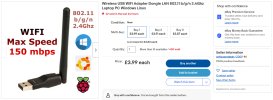Black Hole
May contain traces of nut
There are a number of existing (mostly outdated) threads discussing third-party (ie not the expensive Humax-branded) USB WiFi dongles, and I will add links to them below for reference. I believe not even Humax can supply a dongle suitable for HDR-FOX and HD-FOX these days.
The issue is that the driver built into the HD/HDR-FOX firmware will only work with the Ralink RT3070 WiFi chipset, so the only dongles which will work must be built with the RT3070 (or a clone), but the RT3070 has been superseded (typically by the RT5370).
It is still (or was until recently) possible to buy a RT3070 dongle on the likes of eBay, but it is also possible to buy a dongle advertised as RT3070 which turns out not to be. How do you tell? All you really know is the WiFi settings in Menu >> Settings >> System >> Internet Setting are greyed out and unavailable (make sure there is no Ethernet cable plugged in, otherwise that will take precedence).
With thanks to Ezra Pound for pointing this out, Custom Firmware users can diagnose whether a plugged-in WiFi dongle is indeed RT3070 (or not), regardless of whether the WiFi settings are enabled. On a Telnet or Webshell command line:
The output should be a spew of text, reporting parameters for all current USB-connected devices. If none of the lines prefixed
(ie does not contain "3070"; maybe "5370" or something else), then the dongle is not suitable... and if advertised as RT3070 it has been mis-sold.
In the absence of a suitable WiFi dongle, there are wired or wireless alternatives which work through the Ethernet port and will be seen by the HD/HDR-FOX as a wired network:
References:
The issue is that the driver built into the HD/HDR-FOX firmware will only work with the Ralink RT3070 WiFi chipset, so the only dongles which will work must be built with the RT3070 (or a clone), but the RT3070 has been superseded (typically by the RT5370).
It is still (or was until recently) possible to buy a RT3070 dongle on the likes of eBay, but it is also possible to buy a dongle advertised as RT3070 which turns out not to be. How do you tell? All you really know is the WiFi settings in Menu >> Settings >> System >> Internet Setting are greyed out and unavailable (make sure there is no Ethernet cable plugged in, otherwise that will take precedence).
With thanks to Ezra Pound for pointing this out, Custom Firmware users can diagnose whether a plugged-in WiFi dongle is indeed RT3070 (or not), regardless of whether the WiFi settings are enabled. On a Telnet or Webshell command line:
(I presume this command could actually be run on any Linux system.)cat /proc/bus/usb/devices
The output should be a spew of text, reporting parameters for all current USB-connected devices. If none of the lines prefixed
P: look like this:
Code:
P: Vendor=148f ProdID=3070 Rev= 1.01In the absence of a suitable WiFi dongle, there are wired or wireless alternatives which work through the Ethernet port and will be seen by the HD/HDR-FOX as a wired network:
- Ethernet cable direct to the home router.
- HomePlug (AKA Powerline), which uses the home mains wiring as a carrier for networking. One adapter is plugged into the mains near your router (and connected to the router by an Ethernet cable), and then other adapters plugged into the mains around the house provide networking to your devices. See Devolo or TP-Link (to name but two).
- WiFi-to-Ethernet adapter, such as a nano-router (eg TP-Link WR702N) used in client mode. Power it from the USB port and connect it to the Ethernet port to provide a WiFi connection without relying on a RT3070 dongle (the HD/HDR-FOX will treat it as a LAN connection rather than Wi-Fi).
References:
Last edited:


